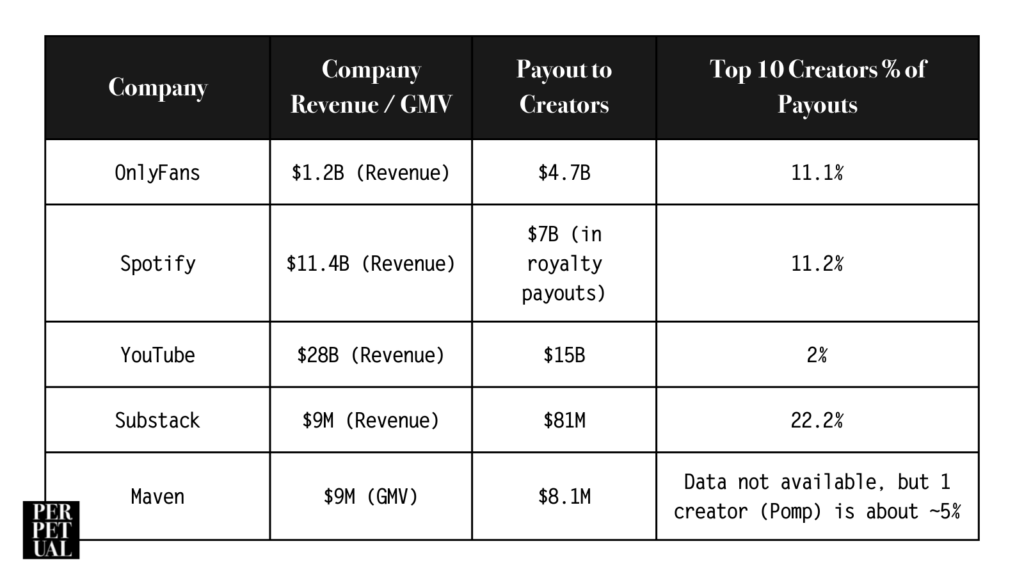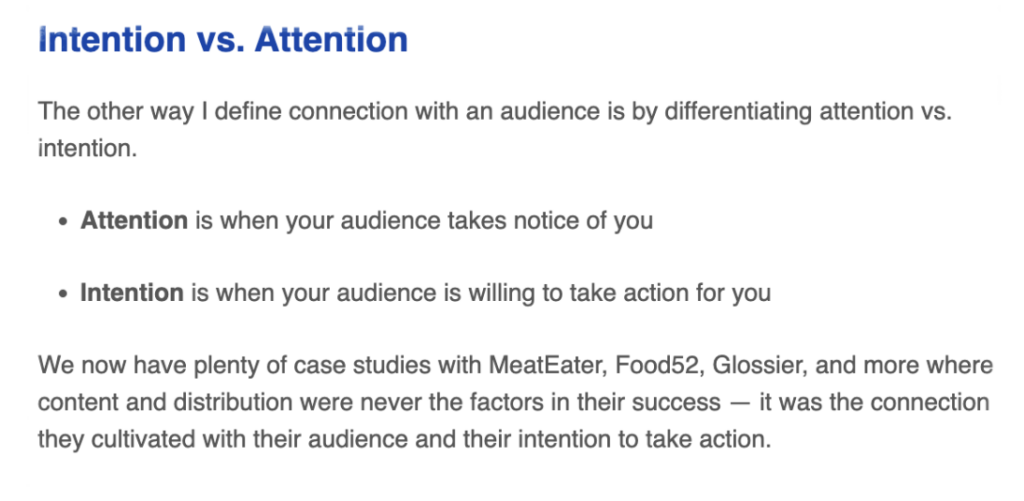16 September 2022 | Media
Is the Creator Economy cratering?
By Adam Ryan
Maven, the ed-tech startup that raised $25M from Andreessen Horowitz, announced a significant business pivot this week.
They’re moving their platform more towards industry experts and less away from influencers.
“We had the hypothesis that a creator with a big audience will have a great course and be able to fill it, and we were surprised that this hypothesis was wrong,” – Wes Kao, Co-Founder of Maven
This pivot comes on the back of Substack, another creator economy play, is cutting back staff and struggling to raise their subsequent financing round.
The elephant in the room
Almost every creator economy platform is struggling to scale.
They almost all built their business model around lowering the barrier to help more people become creators.
more creators = more subscribers = more revenue.
The foundational issue of the creator economy is that most creators aren’t great at what they do.
It’s a power law game.

This graph could be a newsletter in its own right, but no matter how you slice it, this is a bad look for those investing and building in the creator economy space.
It’s simply impossible to not be dependent on your top creators to drive revenue in the industry, even if you’re YouTube.
But what about Mr. Beast?
Mr. Beast is a case study that the creator economy can thrive with a top creator. He is on a path to be the first billionaire YouTuber and has created a blueprint of how big of an ecosystem a single creator can become.
If you don’t live in the bluebird app, here’s the TLDR on Mr. Beast:
- Mr. Beast has 104M YouTube subscribers on his personal page and more than 180M total with all 18 of his channels
- He reportedly makes $54M in revenue a year on YouTube
- He launched a burger restaurant called Beast Burgers. Has 500+ ghost kitchen locations.
- He launched his first physical Beast Burger last week and broke the record for most burgers sold in a day
- And.. just so you feel shitty about yourself… he is 23
What we can learn from him is how he created his rabid fan base.
The way Mr. Beast originally built his following was by creating hilarious clickbait videos that were unique to him. In 2017, he recorded a video of him counting to 100,000. One number at a time.
He gained mass amounts of attention.
But he realized he needed a way to build a connection with his audience beyond hilarious yet mind-numbing content in order to grow from creator to company.
The way he decided to build that connection? Philanthropy.
He used his audience to give him philanthropic ideas. He went viral by giving away luxury cars, $1,000 bands to unhoused people and giving his mom $100,000 for a new home.
This playbook isn’t new. Clue:

The connection his audience felt for Beast due to his selfless and relatable persona built affinity and drove intention to support him with any endeavor he took on.
His empire’s success is now growing faster than Andrew Chen’s write downs.
What can companies learn from Mr. Beast?

This image comes from my 2nd ever issue of Perpetual, which you can read here. It’s the reason why Substack, Maven (thus far), Twitter, and more have all struggled to scale.
Attention is cheap. It’s easy to grab. Even easier to fake. The impact: revenue doesn’t scale.
Intention is hard to gain. It takes consistency and purpose. It takes connection with your audience. The impact: revenue has a higher ceiling than you can imagine.
These platforms assumed that the attention of influencers could drive the intention of the audience to buy a course, a subscription, etc.
The result isn’t pretty.
- Substack did $9M in revenue in 2021 with $85M raised in funds.
- Maven did $9M in GMV over 18 months
- Patreon just laid off 17% of its staff (side note: if you were recently laid off or are looking for a new role, fill this form out to help you find your next career).
- Cameo’s growth has stalled
- Twitter’s Super Follow feature made a whopping $6K in its first two weeks
This is why Mr. Beast has zoomed past his competitors on YouTube.
He evolved his audience from attention to intention by creating a unique connection.
For context, PewDiePie, who has 7M more subscribers than Beast, only makes ~$4M a year. That’s 8% of what Beast makes.
Does this problem of focusing on attention instead of intention sound familiar? Hello, Buzzfeed.
The best creator economy company creating intention and how they did it
OnlyFans, despite dealing with the power law problem, are probably the most successful creator economy startup.
They are the only creator economy “take platform” that is growing rapidly. Their free cashflow grew from $150M in 2020 to $1.2B in 2022 with GMV growing from $2.2B to $12.5B. Killing. It.
How?
OnlyFans looked at foundational issues for the Creators on their platform. They didn’t only focus on monetization optimization for creators, they solved real security problems that their adult content creators were experiencing. They required social verification, license upload, strict rules around meeting in person, and more. By increasing security, they enabled new ways to connect with their audience, like messaging.
Allowing Creators to communicate with their audience in a safe way allowed them to build a connection that had never existed before on an adult content platform.
This newly found ability to create connection fostered intention within the audience that has allowed the platform to increase the addressable market on both the supply and demand side.
Going forward what to expect
I’ve interviewed hundreds of creators in the last year who’ve been creating content for many years. Many never considered going full-time until the last 12-24 months.
The creator economy isn’t cratering, it’s expanding.
The problem is that the companies created to support that growth chose the wrong problem to solve for.
Too many excel jockeys were thinking “if we have X amount of subscribers and we make it easy to sell Y product then we can easily make $X by converting X%”.
As Maven realized, that formula isn’t so easy to bring to life. You need to have audiences with real intention. You can’t assume everyone has a 1,000 true fans, you have to help them get to a 1,000 true fans to scale.
So let’s say goodbye to the “Attention Economy” and hello “Intention Economy.”